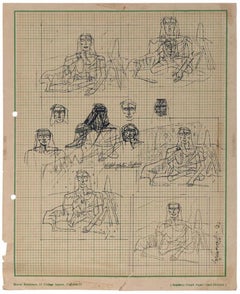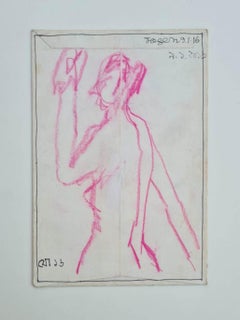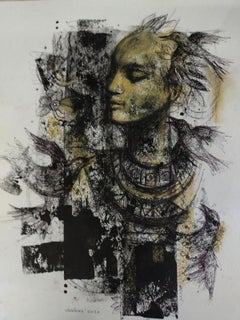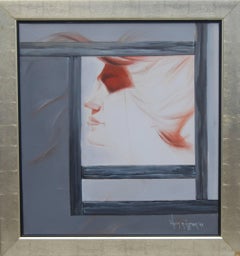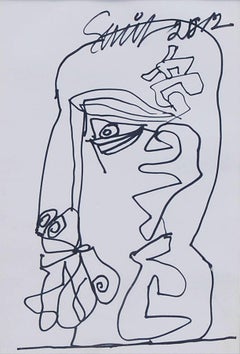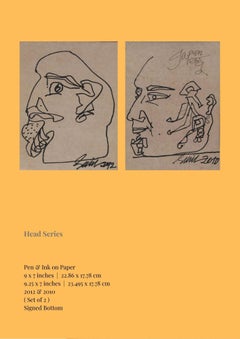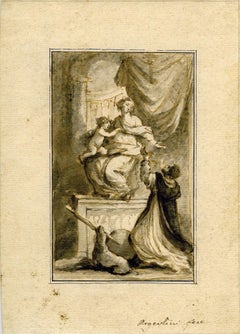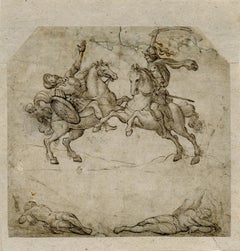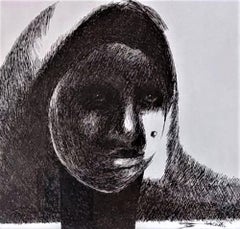India - Portrait Drawings and Watercolors
to
2
8
1
2
Overall Width
to
Overall Height
to
1
10
1
9
2
9
1
1
9
7
5
3
3
3
2
2
2
1
1
1
1
10
7
6
2
2
6
1
1
1
1
4
3
2,177
1,473
Item Ships From: India
Untitled, Pen & Ink on Paper, Black color by Modern Indian Artist "In Stock"
By Ganesh Pyne
Located in Kolkata, West Bengal
Ganesh Pyne - Untitled - 8.25 x 11 inches (unframed size)
Pen & Ink on Paper
Inclusive of shipment in roll form.
Style : Initially, Pyne painted watercolo...
Category
1990s Modern India - Portrait Drawings and Watercolors
Materials
Paper, Ink, Pen
Untitled, Figurative, Pastel on Paper by Modern Artist "In Stock"
By Jogen Chowdhury
Located in Kolkata, West Bengal
Jogen Chowdhury : Untitled
Pastel on Envelop ; 7 x 5 inches ; 2016
Signed by the Artist.
Style : He has immense contribution in inspiring young artists of India. Jogen Chowdhury ha...
Category
2010s Modern India - Portrait Drawings and Watercolors
Materials
Paper, Pastel
$1,148 Sale Price
20% Off
Untitled, Mixed Media on Paper, Black, Yellow by Contemporary Artist "In Stock"
By Sekhar Kar
Located in Kolkata, West Bengal
Sekhar Kar - Untitled, Mixed media on Paper
22 x 28 inches, 2020 (Unframed)
** Free shipping ** Delivered in parcel form mounted but not framed .
Style : Sekhar Kar's paintings de...
Category
2010s Contemporary India - Portrait Drawings and Watercolors
Materials
Paper, Mixed Media
Charulata, Conte & Oil on Canvas, Grey Brown white Color , by Master Artist Wasim
By Wasim Kapoor
Located in Kolkata, West Bengal
Wasim Kapoor - Untitled - 30 x 34 inches ( unframed size )
Oil and Conte on Canvas. . The listed price if for the rolled work . Should you wish to receive it framed the shipping shou...
Category
Early 2000s Contemporary India - Portrait Drawings and Watercolors
Materials
Canvas, Mixed Media, Conté, Oil
Portrait, Japanese Face, Pen & Ink Drawing on Paper, Black & White "In Stock"
By Sunil Das
Located in Kolkata, West Bengal
Sunil Das - Untitled - 9 x 7 inches (unframed size)
Pen and Ink on Paper
Inclusive of shipment in ready to hang form.
The exceptions are the faces such as the profiles of bearded men in which the content is a mere excuse for the lines to create a pattern of untrammeled playfulness. Of course the Japanese face...
Category
2010s Modern India - Portrait Drawings and Watercolors
Materials
Paper, Ink, Pen
Head Series, Pen & Ink on Paper (Set of 2) by Modern Indian Artist "In Stock"
By Sunil Das
Located in Kolkata, West Bengal
Sunil Das - Untitled - 9 x 7 inches & 9.25 x 7 inches (unframed size)
Pen and Ink on Paper, 2012 & 2010 (Set of 2)
Inclusive of shipment in ready to hang form.
The exceptions are the faces such as the profiles of bearded men in which the content is a mere excuse for the lines to create a pattern of untrammeled playfulness. Of course the Japanese face...
Category
2010s Modern India - Portrait Drawings and Watercolors
Materials
Paper, Ink, Pen
Face of Bearded Men, Pen and Ink on Paper by Modern Indian Artist "In Stock"
By Sunil Das
Located in Kolkata, West Bengal
Sunil Das - Untitled - 9 x 7 inches (unframed size)
Pen and Ink on Paper
Inclusive of shipment in ready to hang form.
The exceptions are the faces such as the profiles of bearded men...
Category
2010s Modern India - Portrait Drawings and Watercolors
Materials
Paper, Ink, Pen
Head Series, Pen & Ink on Paper (Set of 2) by Modern Indian Artist "In Stock"
By Sunil Das
Located in Kolkata, West Bengal
Sunil Das - Untitled - 9 x 7 inches (unframed size)
Pen and Ink on Paper, 2010 & 2012 (Set of 2)
Inclusive of shipment in ready to hang form.
The exceptions are the faces such as th...
Category
2010s Modern India - Portrait Drawings and Watercolors
Materials
Paper, Ink, Pen
Head Series, Pen & Ink on Paper (Set of 2) by Modern Indian Artist "In Stock"
By Sunil Das
Located in Kolkata, West Bengal
Sunil Das - Untitled - 6 x 7 inches & 7 x 7 inches (unframed size)
Pen and Ink on Paper, 2012 (Set of 2) Inclusive of shipment in ready to hang form.
for auction : Please Note: The reserve price set is for one work only
The exceptions are the faces such as the profiles of bearded men in which the content is a mere excuse for the lines to create a pattern of untrammeled playfulness. Of course the Japanese face...
Category
2010s Modern India - Portrait Drawings and Watercolors
Materials
Paper, Ink, Pen
Bride & Bridegroom, Watercolour on Paper by Modern Indian Artist "In Stock"
By Shyamal Dutta Ray
Located in Kolkata, West Bengal
Shyamal Dutta Ray - Untitled - 10 x 12 inches (unframed size)
Watercolour on Paper, 1994
Style : The poignant imagery in Shyamal Dutta Ray’s paintin...
Category
Early 2000s Modern India - Portrait Drawings and Watercolors
Materials
Paper, Watercolor
Face, Ink on Paper Black and Brown by PadmaShree Artist Sunil Das "In Stock"
By Sunil Das
Located in Kolkata, West Bengal
Sunil Das - 7.25 x 8.5 inches (unframed size)
Ink on Paper
Inclusive of shipment in ready to hang form.
Sunil Das (1939-2015) was a Master Modern Indian Artist from Bengal. Extremel...
Category
2010s Modern India - Portrait Drawings and Watercolors
Materials
Paper, Ink
Related Items
Neoclassical composition of a sculptor kneeling before his statue of the Madonna
Located in Middletown, NY
An allegory of loyalty, with the subject's dog pictured seated, holding his master's chisel in his mouth; fidelity personified.
Italian School, 18th century
Ink wash in gray and bl...
Category
Mid-18th Century Italian School India - Portrait Drawings and Watercolors
Materials
Laid Paper, Ink, Watercolor
$500
H 9.73 in W 7.01 in
Mythological combat scene with Roman soldiers on horseback.
By Virgil Solis
Located in Middletown, NY
Pen and brownish black ink on grayish-cream laid paper, 6 1/2 x 8 inches (165 x 175 mm), irregular hexagonal sheet with margins. Some archival repairs along the top sheet edge, scatt...
Category
16th Century Old Masters India - Portrait Drawings and Watercolors
Materials
Ink, Laid Paper, Pen
African Mama - Vintage Illustration in Ink and Watercolor
By Irene Pattinson
Located in Soquel, CA
African Mama - Vintage Illustration in Ink and Watercolor
A charming illustration, by Irene Pattinson (American, 1909-1999), shows a woman with a...
Category
1950s American Modern India - Portrait Drawings and Watercolors
Materials
Paper, India Ink, Watercolor, Pen
$636 Sale Price
20% Off
H 13 in W 10 in D 0.25 in
Snobby Chef Big Hat - Upscale Restaurant Sophisticated Taste
By Ludwig Bemelmans, 1898-1962
Located in Miami, FL
We are presenting a rare opportunity to acquire one of Leroy Neiman's best and most compelling paintings. It is a statement piece. A combination of enticing subject matter with a mon...
Category
1960s Outsider Art India - Portrait Drawings and Watercolors
Materials
Ink, Gouache, Archival Paper, Pen
$20,000
H 16.5 in W 20.5 in D 1 in
Rare Modernist Hungarian Rabbi Pastel Drawing Gouache Painting Judaica Art Deco
By Hugó Scheiber
Located in Surfside, FL
Rabbi in the synagogue at prayer wearing tallit and tefillin.
Hugó Scheiber (born 29 September 1873 in Budapest – died there 7 March 1950) was a Hungarian modernist painter.
Hugo Scheiber was brought from Budapest to Vienna at the age of eight where his father worked as a sign painter for the Prater Theater. At fifteen, he returned with his family to Budapest and began working during the day to help support them and attending painting classes at the School of Design in the evening, where Henrik Papp was one of his teachers. He completed his studies in 1900. His work was at first in a post-Impressionistic style but from 1910 onward showed his increasing interest in German Expressionism and Futurism. This made it of little interest to the conservative Hungarian art establishment.
However, in 1915 he met the great Italian avant-gardist Filippo Tommaso Marinetti and the two painters became close friends. Marinetti invited him to join the Futurist Movement. The uniquely modernist style that he developed was, however, closer to German Expressionism than to Futurism and eventually drifted toward an international art deco manner similar to Erté's. In 1919, he and his friend Béla Kádar held an exhibition at the Hevesy Salon in Vienna. It was a great success and at last caused the Budapest Art Museum to acquire some of Scheiber's drawings. Encouraged, Scheiber came back to live in Vienna in 1920.
A turning point in Scheiber's career came a year later, when Herwarth Walden, founder of Germany's leading avant-garde periodical, Der Sturm, and of the Sturm Gallery in Berlin, became interested in Scheiber's work. Scheiber moved to Berlin in 1922, and his paintings soon appeared regularly in Walden's magazine and elsewhere. Exhibitions of his work followed in London, Rome, La Paz, and New York.
Scheiber's move to Germany coincided with a significant exodus of Hungarian artists to Berlin, including Laszlo Moholy-Nagy and Sandor Bortnyik. There had been a major split in ideology among the Hungarian avant-garde. The Constructivist and leader of the Hungarian avantgarde, Lajos Kassák (painted by Hugó Scheiber in 1930) believed that art should relate to all the needs of contemporary humankind. Thus he refused to compromise the purity of his style to reflect the demands of either the ruling class or socialists and communists. The other camp believed that an artist should be a figurehead for social and political change.
The fall out and factions that resulted from this politicisation resulted in most of the Hungarian avant gardists leaving Vienna for Berlin. Hungarian émigrés made up one of the largest minority groups in the German capital and the influx of their painters had a significant effect on Hungarian and international art. Another turning point of Scheiber's career came in 1926, with the New York exhibition of the Société Anonyme, organized by Katherine Dreier. Scheiber and other important avant garde artists from more than twenty-three countries were represented. In 1933, Scheiber was invited by Marinetti to participate in the great meeting of the Futurists held in Rome in late April 1933, Mostra Nazionale d’Arte Futurista where he was received with great enthusiasm. Gradually, the Hungarian artists began to return home, particularly with the rise of Nazism in Germany. Kádar went back from Berlin in about 1932 and Scheiber followed in 1934.
He was then at the peak of his powers and had a special flair in depicting café and cabaret life in vivid colors, sturdily abstracted forms and spontaneous brush strokes. Scheiber depicted cosmopolitan modern life using stylized shapes and expressive colors. His preferred subjects were cabaret and street scenes, jazz musicians, flappers, and a series of self-portraits (usually with a cigar). his principal media being gouache and oil. He was a member of the prestigious New Society of Artists (KUT—Képzőművészek Új Társasága)and seems to have weathered Hungary's post–World War II transition to state-communism without difficulty. He continued to be well regarded, eventually even receiving the posthumous honor of having one of his images used for a Russian Soviet postage stamp (see image above). Hugó Scheiber died in Budapest in 1950.
Paintings by Hugó Scheiber form part of permanent museum collections in Budapest (Hungarian National Museum), Pecs (Jannus Pannonius Museum), Vienna, New York, Bern and elsewhere. His work has also been shown in many important exhibitions, including:
"The Nell Walden Collection," Kunsthaus Zürich (1945)
"Collection of the Société Anonyme," Yale University Art Gallery, New Haven, Connecticut (1950)
"Hugó Scheiber: A Commemorative Exhibition," Hungarian National Museum, Budapest (1964)
"Ungarische Avantgarde," Galleria del Levante, Munich (1971)
"Paris-Berlin 1900-1930," Centre Georges Pompidou, Paris (1978)
"L’Art en Hongrie, 1905-1920," Musée d’Art et l’Industrie, Saint-Etienne (1980)
"Ungarische Avantgarde in der Weimarer Republik," Marburg (1986)
"Modernizmus," Eresz & Maklary Gallery, Budapest (2006)
"Hugó Scheiber & Béla Kádár," Galerie le Minotaure, Paris and Tel Aviv (2007)
Hugó Scheiber's paintings continue to be regularly sold at Sotheby's, Christie's, Gillen's Arts (London), Papillon Gallery (Los Angeles) and other auction houses.
He was included in the exhibition The Art Of Modern Hungary 1931 and other exhibitions along with Vilmos Novak Aba, Count Julius Batthyany, Pal Bor, Bela Buky, Denes Csanky, Istvan Csok, Bela Czobel, Peter Di Gabor, Bela Ivanyi Grunwald, Baron Ferenc Hatvany, Lipot Herman, Odon Marffy, C. Pal Molnar...
Category
Early 20th Century Modern India - Portrait Drawings and Watercolors
Materials
Paper, Charcoal, Pastel, Watercolor, Gouache
$5,500
H 15.75 in W 14.5 in
'Portrait of a Young Navajo', Native American, Arizona, California Woman artist
By Victoria Creech Stewart
Located in Santa Cruz, CA
Signed lower left 'Creech PSWC' and created circa 1975
A compelling pastel study showing the subject dressed in brightly-colored ceremonial robes and gazing past the viewer. An eleg...
Category
1970s American Modern India - Portrait Drawings and Watercolors
Materials
Pastel, Archival Paper
An Intimate, 1940s Modern Portrait Drawing of a Young Woman by Harold Haydon
By Harold Haydon
Located in Chicago, IL
An Intimate, 1940s Modern Portrait Drawing of a Young Woman by Notable Chicago Artist, Harold Haydon (Am. 1909-1994). A finely drawn, introspective portrait in pastel and charcoal o...
Category
1940s American Modern India - Portrait Drawings and Watercolors
Materials
Paper, Charcoal, Pastel
$85
H 14.5 in W 11.5 in D 0.13 in
Indian Dancer - Vintage Illustration in Ink and Watercolor
By Irene Pattinson
Located in Soquel, CA
Indian Dancer - Vintage Illustration in Ink and Watercolor
A stoic, dark-haired woman in elaborate dress is sitting cross-legged in this illustration by Irene Pattinson (American, 1909-1999). Pattinson uses fine ink line detail and a vibrant pink watercolor for a splash of color.
Signed at the bottom, "Irene Pattinson."
Provenance: The Artist, Estate of Irene Pattinson: David Carlson; Estate of Larry Miller Fine Art, Robert Azensky Fine Art.
Presented in a new white mat with foam core backing.
Mat size: 16"H x 12"W
Paper size: 11.75"H x 8.5"W
Image size: 7.5"H x 6.5"W
Irene Pattinson (American, 1909-1999) studied at the California School of Fine Art (now The San Francisco Art Institute), San Francisco State College and The Marion Hartwell School of Design. She was President of the San Francisco Woman Artists Association 1955-56.
Provenance: The Artist, Estate of Irene Pattinson: David Carlson; Estate of Larry Miller Fine Art, Robert Azensky Fine Art.
Solo Exhibitions: Lucien Labaudt Gallery 1955; San Francisco Museum of Art, 1961 (39 works).
Selected Group Exhibitions: San Francisco Art Association Annual 1948, 54, 55; San Francisco Woman Artists, 1957-1960; Oakland Art Museum Annual, 1951, 58; California Palace of the Legion of Honor, 1960; Richmond Art Center, 1955, 56, 57, 58; San Francisco Art Institute 1959, 60. The Art Bank of the San Francisco Art Association, 1958, 59, 60, 62, 63; Winter Invitational, California Palace of The Legion of Honor, San Francisco, 1960; Fourth Winter Invitational, California Palace of The Legion of Honor, San Francisco, 1963.
Awards: First Place, San Francisco Woman Artists Assoc., 1957, 1959; San Francisco Art Festival 1957;Literature: San Francisco Art Institute - A catalog of the Art Ban 1962/63; San Francisco and the Second Wave: The Blair Collection
Exhibitions:
1963 The Art Bank of the San Francisco Art Association, San Francisco, CA
1963 California Palace of The Legion of Honor: Forth Winter Invitational, San Francisco, CA
1962 The Art Bank of the San Francisco Art Association, San Francisco, CA
1961 San Francisco Museum of Art, San Francisco, CA
1960 California...
Category
1950s American Modern India - Portrait Drawings and Watercolors
Materials
Paper, India Ink, Watercolor, Pen
$920 Sale Price
20% Off
H 16 in W 12 in D 0.25 in
Woman Laughing - Original Pastel by Michel Simonidy - 1920s
By Michel Simonidy
Located in Roma, IT
Woman laughing is an original artwork by Michel Simonidy.
Mixed media, pastel drawing, and tempera on paper.
Hand-signed by the artist on the lower right. Includes passepartout. St...
Category
1920s Modern India - Portrait Drawings and Watercolors
Materials
Pastel
$300
H 20.08 in W 13.78 in D 0.04 in
A Striking Mid-Century Modern Portrait of a Handsome Young Black Man in Profile
By Harold Haydon
Located in Chicago, IL
A Striking Mid-Century Modern Portrait of a Handsome Young Black Man by Noted Chicago Artist, Harold Haydon (Am. 1909-1994). A wonderful executed studio figure study portrait depict...
Category
Mid-20th Century American Modern India - Portrait Drawings and Watercolors
Materials
Paper, Pastel, Graphite
$135
H 12 in W 12 in D 0.13 in
Lounge Chair Nap - Vintage Illustration in Ink and Watercolor
By Irene Pattinson
Located in Soquel, CA
Lounge Chair Nap - Vintage Illustration in Ink and Watercolor
A man lazes in a lounge chair, book still in hand, as he dozes off with a content e...
Category
1950s American Modern India - Portrait Drawings and Watercolors
Materials
Paper, India Ink, Pen
$440 Sale Price
20% Off
H 12 in W 9 in D 0.25 in
Seaman in petticoat breeches and slops, smoking a pipe, carrying a carpetbag.
Located in Middletown, NY
English School, 18th century
Pen and black ink with gray wash on cream laid paper, 9 1/4 x 5 inches (238 x132 mm). 1/4 inch repaired loss, top center, to the left of the figure’s h...
Category
18th Century Realist India - Portrait Drawings and Watercolors
Materials
Ink, Watercolor, Laid Paper, Pen
Previously Available Items
Untitled, Ink & Cross Hatch on Paper by Modern Indian Artist “In Stock”
By Bikash Bhattacharjee
Located in Kolkata, West Bengal
Bikash Bhattacharjee - Untitled - 9 x 9 inches (unframed size)
Ink & Cross Hatch on Paper ( frames to be 17 x 17 inches approx )
Inclusive of shipment in framed form
Style : Bikash Bhattacharya is credited with bringing realism back to Indian art at a time when artists in India were leaning more towards distortion of figures and abstraction. Besides painting the city and its people that he knew so well, Bhattacharjee was an accomplished portrait painter. Realism was Bhattacharjee’s forte; his oil paintings could depict the exact quality of drapery or the skin tone of a woman. He achieved mastery in capturing the quality of light.
Bhattacharjee achieved an enigmatic quality in his paintings that works on many levels from the visual to the subconscious. Subject matter included depictions of the female form, and people of all ages and situations—old men and women, children, domestic help. He had the ability to create an authentic milieu as a background to the characters to heighten the drama.
Bikash had been deeply influenced by the surrealists, and stated that Salvador Dalí was his favourite painter.
About the Artist and his work :
Bikash Bhattacharjee (1940 - 2006) was born in Kolkata.
Education :
At a very early age he lost his father. The consequent struggle for survival left him with a deep sense of insecurity as well as an empathy for the under-privileged, who often feature in his works. In 1963, he graduated with a Diploma in Fine Arts from Indian College of Art and Draftsmanship.
Teaching Career :
Bhattacharjee taught at Indian College of Art and Draftsmanship from 1968 to 1972. He taught at the Government College of Art & Craft, Kolkata from 1973 to 1982. In 1964, he became a member of the Society of Contemporary Artists.
Solo Exhibition : His first solo exhibition was at Kolkata in 1965.
Group Shows :
2016 – Dag Modern, New York, The Art of Bengal
2016 – Akara Art, Mumbai, Mysteries of the Organism
2015 – Dag Modern, New York, The Naked and the Nude: The Body in Indian Modern Art
2015 – Dag Modern, Mumbai, India Modern – Narratives from 20th Century Indian Art...
Category
1960s Modern India - Portrait Drawings and Watercolors
Materials
Paper, Ink
Musings, Pen-Ink Drawing, Blue by Eminent Modern Indian Artist "In Stock"
By Somnath Hore
Located in Kolkata, West Bengal
Somnath Hore - Untitled - 7 x 10.5 inches ( unframed size)
Pen and Ink on paper
Provenance and Certificate: Bought directly from the artist and certified by the Artist's daughter, M...
Category
1970s Modern India - Portrait Drawings and Watercolors
Materials
Paper, Ink, Ballpoint Pen
H 15 in W 18.5 in D 1 in
Potrait, Charcoal, Canvas, Black, White, National Awardee Indian Artist"In Stock"
By Thota Vaikuntam
Located in Kolkata, West Bengal
Thota Vaikuntam - Untitled - 10 x 8 inches (unframed size)
Charcoal on canvas
Inclusive of shipment in roll form
Style :
Men and women of his village are often the central character...
Category
Early 2000s Modern India - Portrait Drawings and Watercolors
Materials
Canvas, Charcoal
